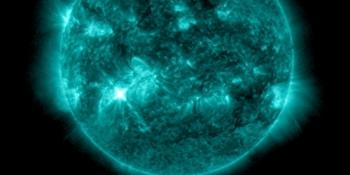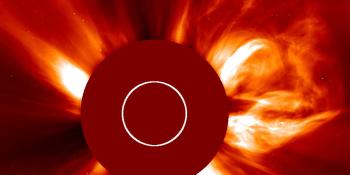Przeglądasz Archiwum z niedziela, 22 czerwca 2003
Raport aktywności słonecznej
Każdy wspomniany rozbłysk słoneczny w tym raporcie ma współczynnik skalowania dodany przez Space Weather Prediction Center (SWPC). Przez skale współczynników SWPC, raporty o rozbłyskach słonecznych są o 42% mniejsze niż naukowo jakościowa data. Skale współczynników zostały usunięte z naszych archiwów o rozbłyskach słonecznych by odzwierciedlić prawdziwe jednostki fizyczne.
Raport aktywności słoneczno- geomagnetycznej 2003 Jun 22 2200 UTC
Przygotowane przez NOAA © SWPC i przetworzone przez SpaceWeatherLive.comPołączenie raportów USAF/NOAA o słonecznej i geofizycznej aktywności
Numer SDF 173 wydany w 2200Z na 22 Jun 2003
IA. Analiza aktywności regionów słonecznych i aktywność od 21-2100Z do 22-2100Z
Solar activity was low. Just a single C-class flare
this period - a C1/Sf at 22/0949Z from Region 388 (S02W32). This
region has shown little change this period and still contains some
weak magnetic mixing. Moderately complex Region 386 (S06W08) still
maintains a weak delta configuration, but was quiet this period as
it continues to slowly decay. Region 387 (N18E10) is the largest
region the visible disk, but was also quiet. A new region rotating
around the east limb was numbered today as Region 390.
IB. Prognoza aktywności słonecznej
Solar activity is expected to continue
at low levels. There is a small chance for an isolated low M-class
flare from Regions 386, 387 and 388.
IIA. Podsumowanie aktywności geofizycznej 21-2100Z do 22-2100Z
The geomagnetic field was unsettled to active due to a high speed
coronal hole stream. The greater than 2 MeV electron flux at
geosynchronous orbit reached high levels today.
IIB. Prognoza aktywności geofizycznej
The geomagnetic field is
expected to continue at unsettled to active levels due to coronal
hole high speed flow.
III. Prawdopodobieństwa zdarzenia 23 Jun do 25 Jun
| Klasa M | 25% | 25% | 25% |
| Klasa X | 05% | 05% | 05% |
| Proton | 05% | 05% | 05% |
| PCAF | green
|
IV. Przepływ 10,7 cm z Penticton
Zaobserwowano 22 Jun 110
Przewidywane 23 Jun-25 Jun 110/115/115
Średnia z 90 dni 22 Jun 126
V. Indeks geomagnetyczny A
Zaobserwowano Afr/Ap 21 Jun 016/023
Szacowane Afr/Ap 22 Jun 015/015
Przewidywane Afr/Ap 23 Jun-25 Jun 015/015-012/012-012/012
VI. Prawdopodobieństwa aktywności geomagnetycznej 23 Jun do 25 Jun
| A. Średnie szerokości geograficzne |
|---|
| Aktywne | 35% | 30% | 30% |
| Słaba burza | 15% | 10% | 10% |
| Bardzo znacząca burza | 05% | 05% | 05% |
| B. Wysokie szerokości geograficzne |
|---|
| Aktywne | 40% | 35% | 35% |
| Słaba burza | 20% | 15% | 15% |
| Bardzo znacząca burza | 10% | 05% | 05% |
Comments
K-Indices
On 16 June, it was determined that a scaling problem exists with the Boulder magnetometer instrument. While this problem, and its fix are being investigated, the primary instrument for Boulder K-indices has been switched to the Boulder USGS (via Domsat) magnetometer, effective 1500 UTC on 16 June.
GOES Protons
To ensure continued operational monitoring of important energetic particle data, it is necessary to reassign primary/secondary designations for the GOES Space Environment Monitor (SEM) detectors. GOES 11 (113W) is now the primary satellite for protons. GOES 12 will continue as the primary satellite for magnetometer, X-ray, and electron measurements. GOES 10 (135W) will be the secondary satellite for all SEM sensors - magnetometer, X-ray, and energetic particles. Because of the degraded state of the proton data on GOES-10, its designation as the secondary source for proton data is a short-term solution. More permanent solutions have been identified and are being evaluated. Users will be notified when we define and schedule a permanent fix. Further details can be found at http://www.sec.noaa.gov/GOES.html.
Wszystkie czasy w UTC
<< Idź do codziennego przeglądu



